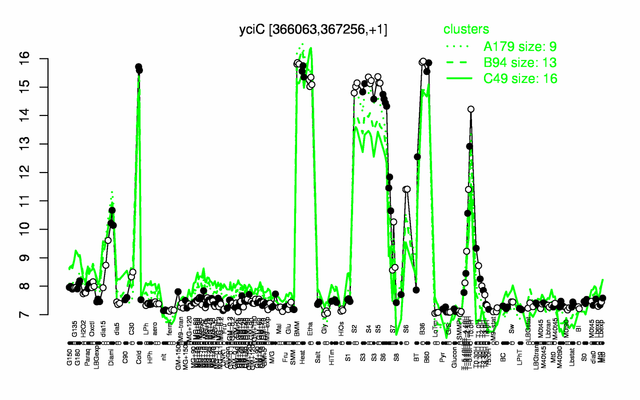Difference between revisions of "YciC"
| Line 132: | Line 132: | ||
* '''Additional information:''' | * '''Additional information:''' | ||
| + | ** number of protein molecules per cell (minimal medium with glucose and ammonium): 448 {{PubMed|24696501}} | ||
=Biological materials = | =Biological materials = | ||
Revision as of 10:03, 17 April 2014
- Description: putative metallochaperone
| Gene name | yciC |
| Synonyms | |
| Essential | no |
| Product | putative metallochaperone |
| Function | zinc uptake |
| Gene expression levels in SubtiExpress: yciC | |
| Metabolic function and regulation of this protein in SubtiPathways: yciC | |
| MW, pI | 45 kDa, 4.399 |
| Gene length, protein length | 1191 bp, 397 aa |
| Immediate neighbours | yczL, yckA |
| Sequences | Protein DNA DNA_with_flanks |
Genetic context 
This image was kindly provided by SubtiList
| |
Expression at a glance PubMed
| |
Contents
Categories containing this gene/protein
trace metal homeostasis (Cu, Zn, Ni, Mn, Mo), membrane proteins, phosphoproteins
This gene is a member of the following regulons
The gene
Basic information
- Locus tag: BSU03360
Phenotypes of a mutant
Database entries
- BsubCyc: BSU03360
- DBTBS entry: [1]
- SubtiList entry: [2]
Additional information
The protein
Basic information/ Evolution
- Catalyzed reaction/ biological activity:
- Protein family: cobW C-terminal domain (according to Swiss-Prot)
- Paralogous protein(s):
Extended information on the protein
- Kinetic information:
- Domains:
- Modification:
- phosphorylated on Arg-58 PubMed
- Cofactor(s):
- Effectors of protein activity:
- Localization: membrane associated PubMed
Database entries
- BsubCyc: BSU03360
- Structure:
- UniProt: P94400
- KEGG entry: [3]
- E.C. number:
Additional information
Expression and regulation
- Regulation:
- Regulatory mechanism:
- Additional information:
- number of protein molecules per cell (minimal medium with glucose and ammonium): 448 PubMed
Biological materials
- Mutant:
- Expression vector:
- lacZ fusion:
- GFP fusion:
- two-hybrid system:
- Antibody:
Labs working on this gene/protein
John Helmann, Cornell University, USA Homepage
Your additional remarks
References